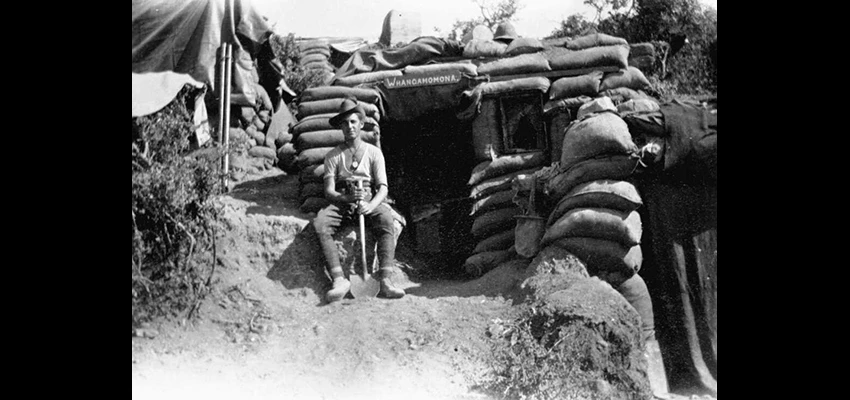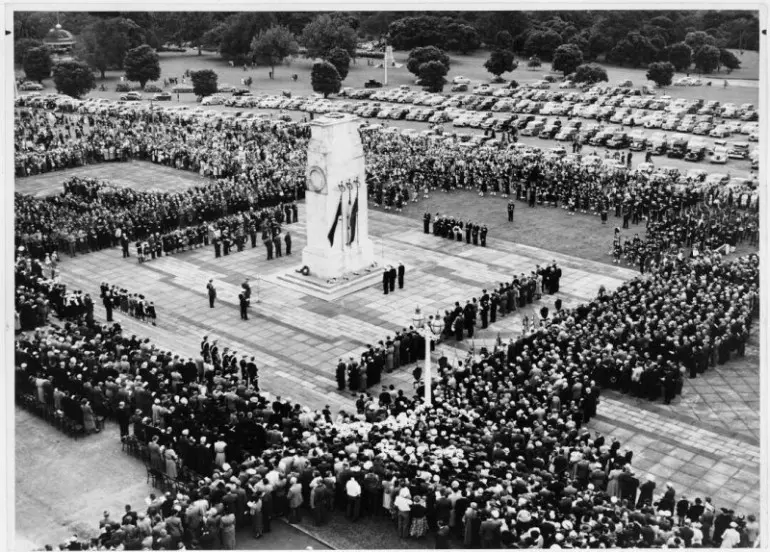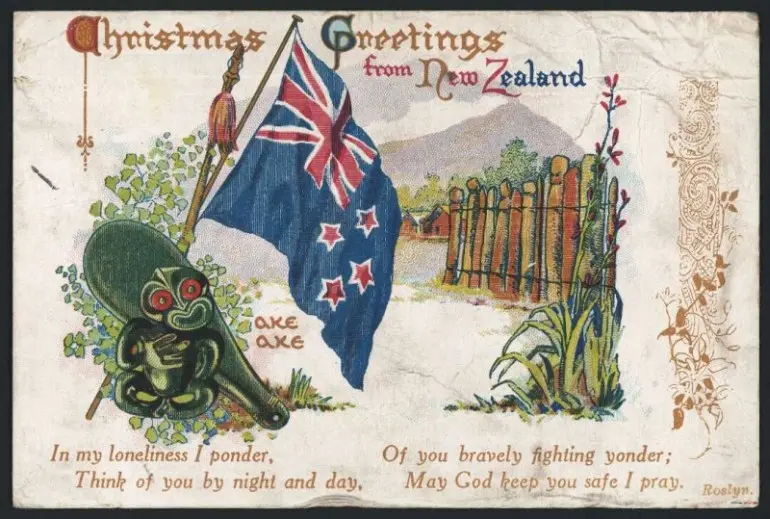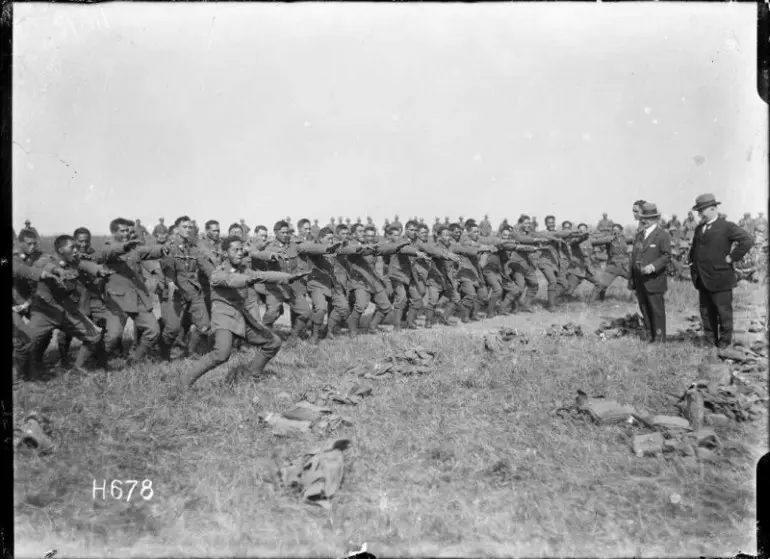
World War 1 (WW1) resources
Explore these curated, online First World War and WW100 commemoration learning resources you can use at school. Many cover the experiences and perspectives of New Zealanders at the time. The guide includes images, articles, video, events, and databases.
Visiting the National Library in Wellington
General reading room
On the first floor you can use Library collections with relevant material in the reading rooms.
The New Zealand and Pacific Collection holds books about New Zealand’s involvement in the war. The Pictorial Collection contains images connected with the war that you can view, photocopy, or order.
Our librarians will also be able to tell you about other collections you may want to explore, depending on your student's questions.
National Library online resources
A number of National Library websites hold or link to a range of valuable New Zealand First World War related resources. These include:
AnyQuestions – This online schoolwork help is available to students across the country between 1pm and 6pm Monday to Friday, except school holidays. Log on and chat with a research librarian to help source online information about your First World War question.
Many Answers provides comprehensive answers to New Zealand student’s research questions about the war.
DigitalNZ – Use DigitalNZ to search for First World War related material (both historic and contemporary) across New Zealand’s major digital collections. You can also view, create and share topic sets of war-related items. Tip: Use the following general keywords to begin your search: 'First World War' or 'World War One'. You can also use the filters to narrow your results.
EPIC – Several EPIC databases provide extensive information on the First World War suitable for both students and teachers. The following databases hold many reference and primary sources, articles and multimedia that are not available on the free internet: Australia/New Zealand Reference Centre, Britannica School (covers primary, middle and secondary levels) and World History in Context. To use the EPIC databases, a school login and password is required.
First World War Research Guide – This comprehensive guide to Alexander Turnbull Library and National Library of New Zealand collections covers First World War material and also links to relevant external sources. Suitable for teachers and senior secondary school students.
Services to Schools Topic Explorer – Has a selection of online resources covering First World War topics, including primary sources.
National Library website – Here you can access thousands of digitised First World War items. Use a broad search first to see what’s available. Try keywords like 'World War One', and 'Great War'. For events and people use specific keywords such as Gallipoli, Passchendaele, or Colonel Malone. Tip: When your search results are returned click View Gallery if you wish to limit your results to images.
Papers Past – Discover more than two million pages of digitised New Zealand newspapers published between 1839 and 1945. Many include articles covering the war period 1914-1918.
Other New Zealand online resources
For First World War curriculum related material use the Ministry of Education's First World War Inquiry guides and resources website. This site has made available First World War inquiry guides (English medium) and resource packs (Māori medium) to support students in years 1 to 13 to meet achievement objectives across The New Zealand Curriculum and Te Marautanga o Aotearoa.
You can also explore the following New Zealand websites for a wide selection of information and resources relating to New Zealand and the First World War.
Anzac Govt – A guide to the significance of Anzac Day for New Zealanders.
Archives New Zealand: Discover World War One – This WW1 landing page lets you search the Archives New Zealand database for the personnel files of New Zealanders serving in World War One. Other First World War resources available include the New Zealand War Art Collection.
Auckland Libraries – Auckland Libraries hold a photographic collection by Herman John Schmidt featuring First World War soldier portraits.
Auckland War Memorial: Cenotaph database – Auckland War Memorial Museum’s cenotaph database allows you to search for information about New Zealand men and woman who served during the First World War.
Christchurch City Libraries – Offers a range of digitised First World War items including letters, diaries, poems and posters.
First World War in maps – New Zealand History online have arranged all First World War maps in one place on a single page. You can click on each map for fuller contextual information. Includes: campaign maps, maps of countries involved in the First World War and cemetery maps (New Zealand and overseas) of personnel who died in or served during the First World War.
Letters from Hell: Gallipoli heroes in their own words – “The 20th century Anzac battles fought on the Gallipoli Peninsula were documented by the ordinary soldiers in hundreds of letters published in the Herald and other newspapers after being passed on by the families of the men.”
New Zealand and the First World War – This NZHistory site provides comprehensive information on New Zealand's involvement in the First World War and aftermath. It also includes an excellent outline resource that covers researching New Zealand soldiers in the First World War.
The New Zealand Electronic Text Collection – This collection provides over 80 digitised First World War books and other related materials, including the histories of the Canterbury, Wellington, and Auckland Mounted Rifles and regiments, as well as The New Zealanders at Gallipoli and much more.
New Zealand WW100 – The major WW100 commemoration site that shares and promotes New Zealand First World War centenary projects and activities, whether national, community-based or personal. The site includes: Discover WW1 – articles about aspects of the First World War; a New Zealand at War Timeline, and Life 100 years ago – Daily quotes from diaries, letters, newspapers shared exactly 100 years later through Twitter, Facebook or the website.
Pukeahu National War Memorial Park Reveals the story of the redeveloped Pukeahu National War Memorial Park (in Wellington) through four virtual field trips run for New Zealand schools. Includes information about the Arras tunnel, and the park. Links to videos and other teaching resources are included.
Te Ara First World War – Discover comprehensive information about the First World War from the online encyclopaedia Te Ara.
Te Papa Tongarewa – Visit the Museum of New Zealand’s website to discover relevant exhibitions and search for collection items relating to the First World War including photographs, maps, medals and other war objects.
Voices Against War – This site investigates some of the stories of young Canterbury men who chose not to go to the First World War because of their beliefs. As a result many ended up in prison.
Walk with an ANZAC Educational Resource – Walking With An Anzac is an educational project that focuses on supporting NZ students and their teachers to actively use the online records of First World War Soldiers from their local community.
The Anzacs of Gallipoli – A website that investigates Anzac soldiers and their daily life at Gallipoli with the aim of engaging students. The site includes background information, images and a range of great learning activities.
The War to End all Wars – Radio New Zealand presents a comprehensive look at the First World War from a New Zealand perspective. Includes oral history excerpts (War Report) and an ANZAC interactive with a current focus on Gallipoli.
WW100 Sites & Sources – A selection of sites and sources for learning about the history of the First World War from a New Zealand perspective. Includes links to guides, fact sheets and activities for teachers.
WW100 Teaching Resource – This comprehensive First World War resource was developed by Christchurch City Libraries. It is designed for teachers and focuses largely on Canterbury’s involvement in the war. Suitable for year 7-10 students the teaching resource also includes extensive e-resources and book lists.
Overseas First World War sites
Australian War Museum – The Australian War Memorial combines a shrine, a world-class museum, an extensive archive and online information covering Australia’s role in the First World War.
BBC World War One – The BBC presents comprehensive information on the First World War including interactive guides, a virtual tour of a World War One trench and also an animation of army movements from 1914 through 1918.
Encyclopedia of the First World War is an international free online encyclopedia. Its extensive content comes from more than 1,000 authors, editors and experts across fifty countries. New Zealand content is included.
Firstworldwar.com: Memoirs & Diaries – Presents a selection of excerpts from diaries of First World War soldiers. Also includes a number of personal narratives relating to specific aspects of the war.
Imperial War Museums – To mark the First World War Centenary, the Imperial War Museums has created Lives of the First World War with the aim of bringing together material from families, museums, libraries and archive collections from around the world.
The Library of Congress web guide – A guide to World War 1 materials presents links to a number of online collections including a wide range of First World War related primary sources. A Teachers’ page provides links to selected resources outlining reasons behind the US involvement in the First World War.
Spartacus Educational – In addition to their print resource, The Spartacus encyclopedia the Spartacus Educational website contains an extensive range of First World War topics including: Outbreak of war, Important battles, Life in the trenches, Women at war, War poets, and also First World War statistics.
The Long, Long Trail – A source of information about the order of battle for the British Army in the First World War. Includes sections on how to research a soldier, the battles, battlefields and more.
Trove – Search across the digitised collections of Australia’s cultural institutions (including the Australian National Library) to discover online resources related to the First World War and ANZACs.
WW1 Poetry Archive – This Poetry Digital Archive holds over 7000 items of text, images, and video relating to First World War poetry.

Image credit: Anzac Day service, Auckland Domain, 1955. Ref: 1/2-068204-F Alexander Turnbull Library.
Places to visit
Here is a list of prominent places to visit during the commemoration of the First World War. Please check their websites for more details.
Auckland War Memorial Museum – This museum is a war memorial for Auckland. It features a dynamic exhibitions programme and houses significant cultural and military history collections.
MOTAT – As New Zealand's biggest technology museum, MOTAT showcases many interactive and working exhibits and their role in New Zealand’s social history.
National Army Museum – New Zealand’s most significant military museum boasts a wide range of New Zealand related military material, from tanks to extensive war related archival material.
Te Papa – Our national museum, Te Papa is based in Wellington and holds significant collections featuring New Zealand’s natural and cultural history. Currently it is displaying Gallipoli: The scale of our war a a free exhibition covering the Gallipoli campaign and co-produced by Weta Workshops.
Armistice in Cambridge – Each year in November Armistice in Cambridge commemorates the signing of the Armistice that ended the First World War. Included are displays of militaria and battle re-enactments.
Pukeahu National War Memorial Park – Visit our National War Memorial and park, in Wellington. Information about the park is provided on the site.
Videos
A global guide to the First World War – Ten historians from 10 countries give a brief history of the First World War through a global lens. Includes video, slideshows and interactive component.
Keep calm and carry on. How can we deal with conflict? – This excellent video showcases a whole school inquiry from Sylvia Park School. Using the primary First World War inquiry guides as a base the school investigates how we deal with conflict.
NZ On Screen – NZ On Screen has a great collection of New Zealand documentaries, films and programmes featuring Anzac Day, the First World War and other military-related programmes.
War Story– War Story is a series of videos covering a range of New Zealand WW1 topics.
WW1 in colour – Watch this series of remastered colour film featuring footage from the First World War.

Image credit: Christmas greetings from New Zealand, 1914–1918. Ref: Eph-B-POSTCARD-Vol-17-010-1 Alexander Turnbull Library.
Classroom ideas
Some classroom ideas include:
Soldiers Food – Hardtack, also known as ‘Anzac tile’ and ‘Concrete macaroon’ used a simple biscuit recipe of flour, water and salt. It was able to be stored and kept for lengthy periods. The Australian War Memorial has an excellent recipe for making hardtack as well as follow-up educational activities. Also look at this excellent blog post on the ‘real’ ANZAC biscuits sent to New Zealand troops overseas. Includes original and adapted recipes.
Visit your community war memorial – Discover your local war memorial by first visiting NZ History's New Zealand memorials register map.
Pukeahu National War Memorial Park – Visit our National War Memorial and park, in Wellington. Information about educational programmes is provided on the site.
National WWI activities and projects – Visit the WW100 site to see what local initiatives will be held in your area.
NZ History online – This site has a number of ideas classroom ideas and activities based around Anzac day.
Exhibitions
Current national exhibitions worth visiting by schools include:
Te Papa – Gallipoli Exhibition – This dynamic (and free) exhibition at Te Papa in Wellington features some impressive multimedia resources, including eight larger than life models of New Zealanders caught up in the Gallipoli campaign.
Articles and media stories
Here are some interesting media stories relating to New Zealanders and their experience of the First World War overseas and on the home front, historic and contemporary.
Historic media stories
At Gallipoli – ‘In a recent letter from Gallipoli, Major Fletcher says that he had received his first wound, although very slight.’ Poverty Bay Herald, Volume XLII, Issue 13831, 3 November 1915, Page 9.
Evacuation of Gallipoli – A letter in the Nelson Evening Mail from Corporal FC Hammond detailing the Allied evacuation from Gallipoli. Nelson Evening Mail, Volume XLIX, 18 February 1916, Page 4.
On the Gallipoli evacuation of Cape Helles – the Turkish story – Presents the Turkish version of the evacuation of Gallipoli. Marlborough Express, Volume L, Issue 12, 15 January 1916, Page 5.
Pomeroy’s bullets – The strange case of the ghost, the Zeppelin and a New Zealand farmer’s explosive bullets. Evening Post, Volume CXI, Issue 114, 16 May 1931, Page 13.
White feather – ‘James Douglas Stark, brave enough to have been recommended for the Victoria Cross…tough enough to have escaped from Le Havre prison, wounded in 37 places, has received the white feather.’ Auckland Star, Volume LXXI, Issue 5, 6 January 1940, Page 6.
Contemporary media stories
10 inventions that owe their success to World War One – An article that reveals a very eclectic selection of inventions (from daylight saving to vegetarian sausages) attributable to World War One.
Blackadder 'denigrates WWI virtues' – Looks at the First World War in the context of the comedy Blackadder goes forth and the role of humour in teaching history.
Brocton's lost Army 'tribute' excavated – A large scale NZ model of the World War One Messines Ridge sector, has recently been unearthed in England. Look at the original model.
Refugee Torty leads an epic life– A tortoise bought back from Gallipoli by a soldier is still alive. ‘She's war-wounded, battered and estimated to be well over a century old, but she still turns heads. She's been run over by a gun carriage, stolen and put in a circus, and once made a bolt for freedom that nearly cost her life.’

Image credit: Pioneer Battalion performing a haka, 1918. Ref: 1/2-013282-G Alexander Turnbull Library.
Responsible use — copyright and attribution
When you use any of these digital First World War resources, be aware of their copyright requirements and usage restrictions. These usually are made clear on the website.
If you use a resource, it's important that you acknowledge or attribute it in your work. Check if your school has guidelines for responsible use of other people's work.
If you're unsure about how to use these digital resources responsibly, ask your librarian or refer to:
Copyright guidelines for schools — as set out by the Ministry of Education.
Creative Commons — a non-profit organisation that helps people legally share, reuse, and even remix creative products and knowledge.
National Library copyright and privacy — statements about the use of National Library web content and information.
Books and other resources
Use National Library's lending service to access books from our school lending collections.
Schools can also request free copies of articles about the war from New Zealand magazines and newspapers (since 1987) using Index New Zealand (INNZ).
Image credit: An unidentified New Zealand soldier outside his dug-out, 1914-1918. Ref: PA1-o-026-22-5. Alexander Turnbull Library.